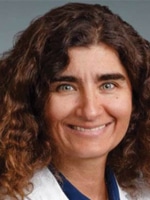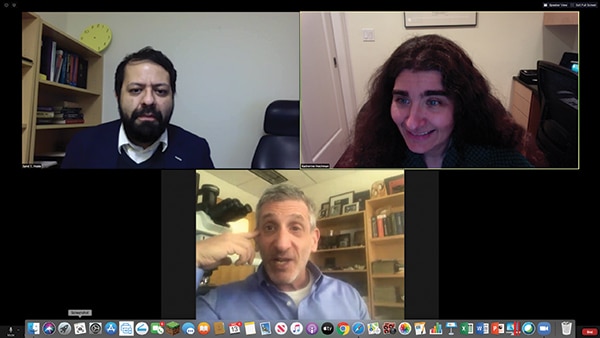Charna Albert
June 2020—At NYU Langone Health, pathologists and others typically not seen out front in the fight against COVID-19 became the bridge between families and the floors.
When Katherine A. Hochman, MD, associate chair for quality in the Department of Medicine at NYU Langone, contracted a mild case of COVID-19, she finally had a chance to take a step back and think. Before going into quarantine to recover, Dr. Hochman had been on the floors day in and day out attending to COVID-19 patients.

Dr. Hochman
“What bothered me when I was on the wards was that there was this major disconnect of information,” Dr. Hochman, who is also the assistant chief of the medicine service, told CAP TODAY on April 23. “Families were not allowed to visit, and the teams were inundated with patients. They didn’t have time to call families. As you can imagine, the families started getting very anxious.”
“In quarantine,” Dr. Hochman continues, “I still wanted to be able to make a difference, and this stuck out to me. So I asked myself, what’s the ideal?”
The ideal, she decided, would be that every family of every patient would get a daily update from a medical professional. These updates didn’t need to come directly from the frontline team attending to patients in the wards and ICUs. Other physicians could make the calls. She quickly organized a new program that became known as NYU Family Connect: 150 attending physicians from pathology, radiology, dermatology, neurology, urology, medicine, orthopedic surgery, and pediatrics, and close to 100 medical students, many working remotely and making daily phone calls to keep families informed.
“Within five days we got groups of medical students, radiologists, and pathologists whose normal work had been displaced by the COVID-19 pandemic. Radiologists didn’t have as many studies to read, and they still wanted to contribute. And pathologists as well, they wanted to contribute to the cause,” says Dr. Hochman, who is also an associate professor at NYU Grossman School of Medicine.
“I raised my hand as soon as I saw the email,” says Syed T. Hoda, MD, clinical associate professor of pathology, director of bone and soft tissue pathology, and director of surgical pathology at NYU Langone Orthopedic Hospital, referring to the call Dr. Hochman put out for physicians to join the program. “And it was amazing how 20 pathologists did the same,” says Dr. Hoda, who became the pathology department lead for the program, directing four teams of pathologists, with the “enthusiastic support,” he says, of the pathology department’s chair, Iannis Aifantis, PhD, and vice chair, Joan F. Cangiarella, MD.
Before the recruits began making calls, Dr. Hochman led them through a week-long training process, beginning April 3. “This was in my bedroom quarantine,” she says. “I trained pathologists [and other doctors] to look in the clinical chart and pick out key pieces of information about COVID patients—how much oxygen they are on, what is the trend of their oxygen requirements, what about their inflammatory markers, what about the COVID-directed treatments. They would take notes on patients, just like you would get to know a patient clinically on the wards. They would try to understand the patient from the chart.”

Twenty pathologists, among them Dr. Neil Theise (bottom) and led by Dr. Syed T. Hoda (left), signed on to help Dr. Katherine Hochman (above), while she quarantined at home, launch NYU Family Connect. “I don’t want us to be invisible anymore,” Dr. Hoda says of pathologists.
The next step for the team was to start attending daily rounds. Using WebEx, the Family Connect team began to join the frontline team on the floors—virtually. “They would go through all the patients, and the Family Connect team would be able to hear from the frontline team how the patient was doing relative to how they did yesterday, and the plan for the day,” Dr. Hochman says.
The daily rounds from the ICU units were intimidating at first, says Dr. Hoda, who spoke with CAP TODAY on April 21. “When you have 30 patients to cover in 15 minutes, the rounds are going to fly. We were on WebEx and couldn’t look at each other, but I think all of us were staring at the phone wondering how we were going to manage collecting so much data in 20 seconds.” But, he says, “You start to get familiar with that way of communicating pretty fast. After the first day of doing rounds and calling families, I felt more comfortable than I could have ever imagined.”
The third component of training required listening in on family calls. “We kept it succinct,” Dr. Hochman says, running through a script of a typical call. “I read through the chart, I spoke with the team, the patient is the same, better, or worse, the plan for the day, and then if there are any questions the family has.” The training was helpful for the pathology team, Dr. Hoda says, many of whom are highly specialized. “I talk to patients about sarcomas and malignant rare tumors, sometimes, on the phone. But to talk to them about a daily update, we needed to have some reminder of how that conversation goes.” Dr. Hochman also trained Family Connect team members to document a care coordination note in the hospital’s EMR, summarizing the conversation they had with the family.
The teams make about 350 to 400 calls a day, Dr. Hochman says. “We have the whole house covered,” with many physicians working remotely. “You don’t need to step foot in the hospital,” she says, running through a typical day for an attending in the program, each of whom has been paired with a medical student. “You connect with your medical student in the morning, you divide up your patients.” Some of the attendings prefer to listen in on all of their student’s calls, she says, while others may listen in on only the first few the students make. “At the end of the day they also connect and say what was good, what was not good, maybe do some teaching.” And the program has garnered valuable teaching moments for the medical students, Dr. Hochman says. “I always tell the attendings, ‘Play to your strengths. The students will know your subspecialty. So play to your strengths.’ That’s been happening very well.”
Pathologists do bring their own strengths and perspective to interpreting patient charts and then relaying that information to families, Dr. Hoda says. “The way we look at things is very interesting, the fact that we look at the big picture but we also look at the little details that point to something. When I’m looking at a patient chart, and the inflammatory markers that people are following for these patients, nobody knows exactly what they mean. But the way I see it is that I know what a D-dimer is. I know what a C-reactive protein is. I remember during hematopathology seeing what happens to these, and it gives me an idea if the patient is doing better or worse, and I corroborate it with what the clinical team is telling me in a different way. I don’t know if this is exclusive to pathology,” he says, “but I feel that my pathology background does help me in looking at things like that.”
He says his work as a bone pathologist with experience looking at radiology images is helpful too: “I look at the chest x-rays to see how the pneumonia is doing and read the report, and it gives me a picture, a better feel.”
For Neil Theise, MD, professor in the Department of Pathology at NYU Grossman School of Medicine and co-director of gastrointestinal and liver pathology in the Department of Pathology, the program is an opportunity to be of value during the crisis. “We were nervous here in New York because of how steep the curve was and how bad it looked like it was getting, that there would be a need for us to be pulled onto the floor,” he said in an April 21 interview. “If we were asked, of course we would do it, but for many of us—I’m 60 at this point—it was a long time ago that I drew blood on somebody, let alone was making active clinical decisions on the floor.” When he heard about the Family Connect program, he signed up right away.
 CAP TODAY Pathology/Laboratory Medicine/Laboratory Management
CAP TODAY Pathology/Laboratory Medicine/Laboratory Management
